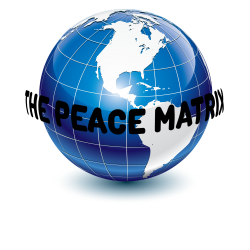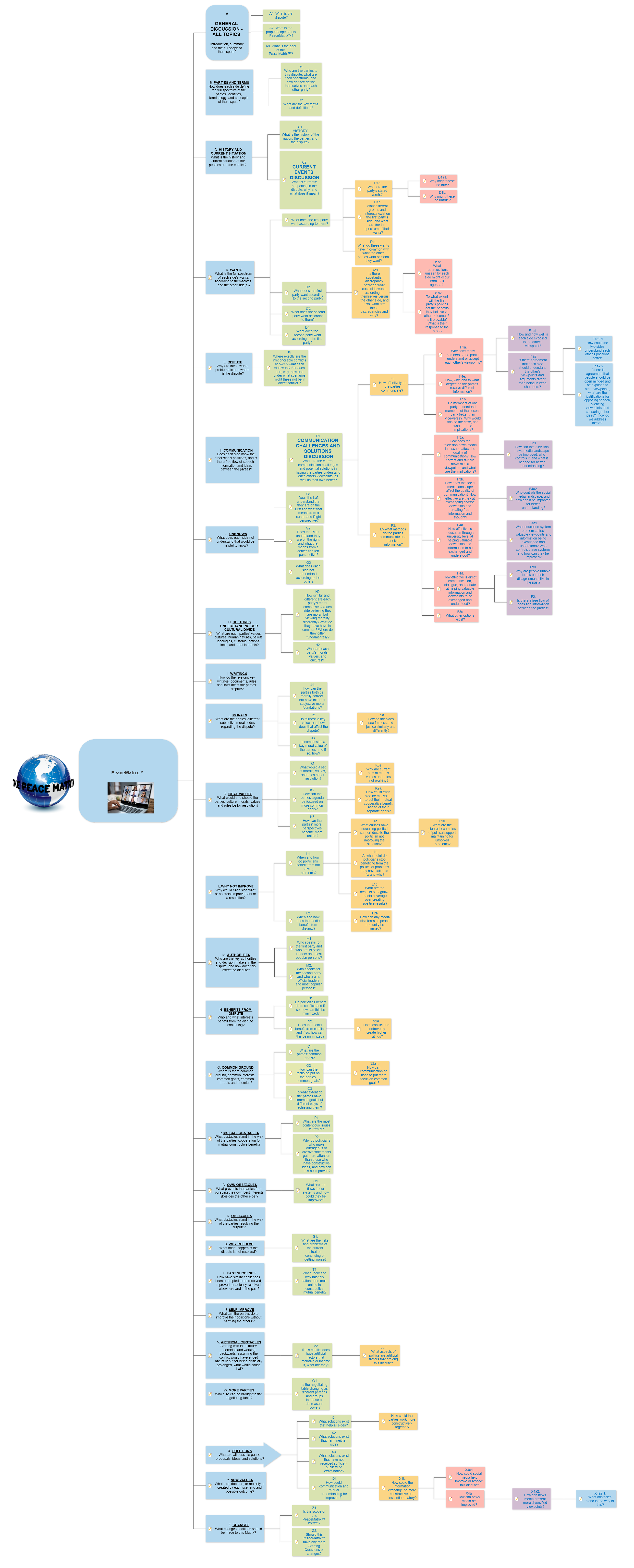The PeaceMatrix™ is a revolutionary new way to analyze and collaborate on solving the biggest, most complex challenges of mankind, toward understanding, and world peace. It turns any conflict between peoples, nations, tribes, religions, ideologies, cultures, factions, groups, political or other viewpoints into an interactive puzzle the whole world can collaborate on solving. It brings everyone literally on the same drawing board, and is a learning tool, a debate, a mediation, negotiation, solution-organization, and peace-building system in one. No longer do the people have to rely on misleading and polarized media, politicians and diplomats, to become involved in understanding, and maybe even solving the world’s complex problems.
The PeaceMatrix™ is an organization system that allows a central location for analysis of a complex global problem, organized constructively to identify all obstacles to peace and prosperity, and allow people to collaborate on resolving them.
The PeaceMatrix™ is designed to help minimize the flaws and failures of other current systems’ of communicating and addressing disputes, including:
- diplomacy
- politics
- executive leadership
- debate forums
- news media
- articles
- informative websites
- books
- research papers
- moderated discussion forums
- blogs
- social media
- educational institutions
- non-government organizations
- the United Nations
- international dispute resolution systems, and,
- international law and its courts, bodies and systems
Yet, can be used as a tool by al of these.
The PeaceMatrix™ is intended to be used when other such systems fail to resolve a dispute that is ongoing.
A PeaceMatrix™ maps out the entire scope of the full broadest view of a dispute, and organizes it from the general to the increasingly more focused strategically, using a guided, tree-structure system to dissect the entire dispute scientifically in one model. It seeks to represent every possible relevant viewpoint, issue, and question, so everyone can be on the same page literally, thereby turning a dispute between potentially millions of people into a single collaborative and constructive project. The PeaceMatrix™ serves as that single proverbial “drawing board”, organizing and managing the exchange of viewpoints, ideas, contributions, and building of constructive solutions. The goal of each PeaceMatrix™ is to map out the entire dispute from the general to the specific so that all constructive views on the subject are represented in the PeaceMatrix™ map. Then, all aspects of each viewpoint are broken down into their sub-components, so we stop arguing over the same inflammatory and side-tracking issues, and rather, to channel efforts toward finding and developing new constructive ideas and solutions.
A unique PeaceMatrix™ is created for each dispute, and given a title and scope to define the dispute and its goal. The PeaceMatrix™ grows and develops under the control of its moderator, called the “architect”. the architect controls and builds the PeaceMatrix™ on that dispute topic, with the team or committee he or she assembles, based on a set of rules and procedures, their abilities, and discretion.
The architect decides which suggested content new is constructive and on point, revises it as appropriate, and adds it to further the completeness and full exchange of ideas in the PeaceMatrix™ in its proper location and designation.
A PeaceMatrix™ can vary in its rules of content submission from an open system where any user in the world may submit content, to a closed system where the PeaceMatrix™ is a diplomatic, teaching, or mediation tool for a specific project with a specific and limited number of participants.
The PeaceMatrix™ is a question-based system, and is designed to run mostly or theoretically even purely on questions, by answering questions with more questions, but in practice it allows hypothesis, facts, sources, information, ideas, solutions, elements, and vulnerabilities, as needed.
The question-based PeaceMatrix™ system
In the PeaceMatrix™, questions are more important than the answers, especially initially. Questions open up new ways of thinking, and should be open-ended and thought-provoking question. As such, questions are mostly addressed by breaking down the subject matter into further questions and hypothesis that dig deeper, from the general to the more specific. Every possibly-useful viewpoint is being sought, not simply one “best”.
The revolutionary organization system
One development that makes the PeaceMatrix™ revolutionary is the first level “Starting Questions” which organize the dispute according to the key elements that make up the human experience of conflict, based on the creative psychological, sociological, legal and philosophical application of the study and analysis of all conflicts between peoples throughout history.
Here is a standard Starting Question lineup.
Generic conflict PeaceMatrix™ starting point:

The Starting Questions:
The various levels of analysis are developed and organized simultaneously, and any part of the PeaceMatrix™ may be moved and changed at any time.
A PeaceMatrix™ organizes a dispute in a solution-oriented manner, in order of priority, working from the general to the specific.
As the PeaceMatrix™ progresses, it develops each Starting Question using the patent-pending process to help continually break down and organize the Starting Question’s subject matter, using more questions, hypothesis, summaries, sources, information, facts, ideas and solutions, in layers of increasingly-focused levels. Each level questions, analyzes and develops the results of the above-level. Each next level can ask any question regarding the previous level to develop or test its correctness, thoroughness and utility.
The PeaceMatrix™ does this by dissecting the Starting Questions and all sub-matter using a “Socratic Method” – type questioning process, similar to how Socrates would question assumptions of his students, by asking for each point, “why?”, or “how do you know?”.
The PeaceMatrix™ system allows for increased open questioning of all points and authorities, and honest, reasoning-based analysis, and presents all relevant viewpoints with a level of honesty, open-mindedness and directness that no politician, diplomat, organization, mediator or negotiator ever could, whether for political reasons, intellectual, practical or other limitations.
The PeaceMatrix™ develops each Starting Question in increasing detail, going deeper and more focused, until all possible issues are broken down into their smallest possible subcomponents, until the conflict’s tapestry are fully identified, isolated, and/or reduced to their smallest and simplest aspects.
The PeaceMatrix™ then, in the “Solutions” section, directs, collects and organizes all constructive ideas and possible solutions corresponding to subcomponents of the mapped-out dispute, allowing the collaborative focusing of ideas and building of solutions for each identified element of the problem. The dispute is mapped out using a visual system to illustrate the levels and sections, and all content is identified unique coordinates, for example, by letter and numeric coordinates, ie: A.1.a., etc.
It need not be decide which viewpoint is correct, as all views can be represented, organized constructively, with solutions being built on them
Submissions for a PeaceMatrix™ being built may be received from up to the whole world, or any subset or group selected to participate, even diplomatic teams from two nations when appropriate, two negotiation teams, a closed group on a for-hire mediation or conflict resolution, or any parties or observers of any dispute.
In summary, the PeaceMatrix™ is a process of organizing and breaking a dispute down to its metaphoric “molecular level”, questioning every assumption, finding its “crux”(es), and then collecting ideas and solutions channeled at those cruxes of the problem, organizing all solution-oriented ideas, and building corresponding solution(s) with such insights and focus. It organizes complex global disputes into a living, growing, interactive work, like turning a conflict into an interactive puzzle potentially the whole world can submit ideas for, collaborate on, and build a solution for together.
Why the PeaceMatrix™ works
The PeaceMatrix™ is designed to pinpoint exactly where people disagree and why (whether on facts, perspectives, morality, rules, law, history, culture, circumstances, etc.) with more specificity and constructive organization than people can accomplish in any debate. It highlights better points to focus on than other systems, and then directs and organizes the focus, and with it constructive ideas, to those pinpoint areas. It systematically seeks out every possible viewpoint, idea, and solution, and finds workarounds to every obstacle. It goes to work to find not one solution to a dispute, but every solution that can possibly exist.
Theories behind the PeaceMatrix™ system include that people are arguing over the wrong issues, perhaps the emotional and inflammatory ones, or the politically-motivated ones, not the points they need to be discussing to solve the problem. Parties are often not arguing about the underlying causal problems, and may not even know what they are. Parties may also be unable to discuss the correct issues constructively enough due to various obstacles. There are underlying issues causing every dispute, and if we can analyze an entire dispute with enough scope and detail and resolve the sub-issues, we will get past the stalemates that continue these conflicts.
The solution is to structure the discussion better, and that’s what the PeaceMatrix™ accomplishes. The PeaceMatrix™ identifies and resolves sub issues and surrounding issues to ultimately solve the unsolvable disputes. Even if the problem is not ultimately resolvable, the PeaceMatrix™ will allow seeing other sides’ viewpoints better. Even if one does not agree with them, it will reduce monolithic thinking in an ongoing constructive process. Also, both sides do not need to even participate, and a PeaceMatrix™ can go to work solving problems entirely with ideas and solutions from one side.
Simple examples
Just as an example, imagine a dispute where two peoples appear to have hit an impasse. As an example, such a conundrum may be the symptom of an entirely different, more complex problem or set of problems. The theory behind the PeaceMatrix™ is that if you assess and address underlying issues properly then solutions and work-arounds will reveal themselves. Perhaps there can be a way to move forward protect one side’s interests while helping both sides or reshaping an aspect of an obstacle that will bring about new efforts, taking energy away from the apparent “impasse.” Perhaps an underlying issue can be resolved, or the world can decide on a better set of rules to apply. Then, if these underlying issues are resolved, the “surface” dispute will then more easily be resolved.
As another example, imagine a dispute over a nation’s political divisions. It may appear that both sides each want their party’s politicians in power, creating an impasse. But according to the theory behind the PeaceMatrix™, a political event may have brought a lot of preexisting problems to the surface, like preexisting political disputes, political correctness, immigration, weaknesses in the political system, media bias and journalistic integrity, racism, and other long-running or worsening disputes between the parties. And, if those other issues are addressed and moved closer to resolution, the “triggering” issue may not be as divisive, or the parties may find a way to move forward constructively despite the disagreement. The PeaceMatrix™ may be valuable because people often do not understand the full and proper scope of a dispute. When political leaders have trouble agreeing on a piece of legislation, it may be because much of the country does not have a proper understanding of the values that each party holds, or the relevant facts or issues, and highlighting them may help resolve the impasse.


